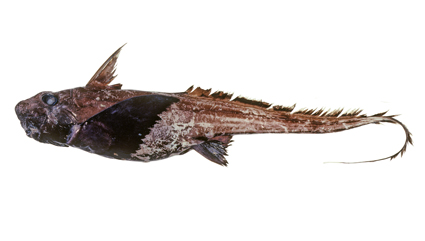Longspine Chimaera, Chimaera macrospina Didier, Last & White 2008

Longspine Chimaera, Chimaera macrospina. Source: Australian National Fish Collection, CSIRO. License: CC BY Attribution-Noncommercial
Summary:
A large uniform dark chocolate-brown chimaera with deciduous skin and a relatively long tail. Although the first dorsal-fin spine is generally taller than the rest of the fin (hence the common name), it ranges in length 18-28% of body depth. Mature males have short, trifurcated claspers that are divided for the distal one-third of their length.
Cite this page as:
Matt B. Reardon & Dianne J. Bray, Chimaera macrospina in Fishes of Australia, accessed 02 Jul 2025, https://fishesofaustralia.net.au/Home/species/2663
Longspine Chimaera, Chimaera macrospina Didier, Last & White 2008
More Info
|
Distribution |
Off Cape Naturaliste to northwest of the Dampier Archipelago, Western Australia, and from the Queensland Plateau west of Lihou Reef & Cays, Coral Sea, southwards to west of Sandy Cape, NW Tasmania. Inhabits depths of 435-1300 m on the continental slope, although the species is more common in depths below 800 m. |
|
Biology |
Egg layers (oviparous). |
|
Fisheries |
Taken as bycatch in commercial trawls. |
|
Author |
Matt B. Reardon & Dianne J. Bray |
Longspine Chimaera, Chimaera macrospina Didier, Last & White 2008
References
Didier, D.A., Last, P.R. & White, W.T. 2008. Three new species of the genus Chimaera Linnaeus (Chimaeriformes: Chimaeridae) from Australia. pp 327-339. In: P.R. Last, W.T. White & J.J. Pogonoski (eds), Descriptions of new Australian Chondrichthyans, CSIRO Marine and Atmospheric Research Paper No. 022.
Kemper, JM, DA Ebert, GJP Naylor & DA Didier. 2015. Chimaera carophila (Chondrichthyes: Chimaeriformes: Chimaeridae), a new species of chimaera from New Zealand. Bull Mar Sci. 91(1): 63-81. Abstract
Last, P.R. & Stevens, J.D. 2009. Sharks and Rays of Australia. Collingwood : CSIRO Publishing Australia 2, 550 pp.
Theiss, S.M., Huveneers, C. & Ebert, D.A. 2015. Chimaera macrospina. The IUCN Red List of Threatened Species 2015: e.T195430A68617345. http://dx.doi.org/10.2305/IUCN.UK.2015-4.RLTS.T195430A68617345.en. Downloaded on 22 January 2016.

